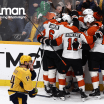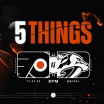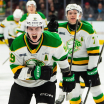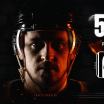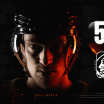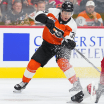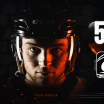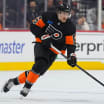It's a long way from Elkhorn, Manitoba, where Flyers defenseman Travis Sanheim was born and raised, to Philadelphia; nearly as long as the journey Sanheim took from being an unheralded minor hockey player in Manitoba to an NHL first-round pick and then from a being a pro prospect to a now-established regular in the Flyers' lineup.
Quiet, pleasant and unassuming by nature, Sanheim does most of his talking on the ice with a combination of his above-average mobility, size (6-foot-4, 200-plus pounds), puck-moving skill and ability to pinch on the play up ice. His play without the puck -- gap control, retrievals, reads -- have also improved significantly from his first pro year to his current third year (second in the NHL). Although he'll never be a crusher in the hitting department, Sanheim is using his frame more to his advantage than he did earlier in his career.
Hitman comes home
In his return to Calgary, Travis Sanheim tells his journey to the City of Brotherly Love

© Icon Sportswire/Getty Images
"I try to work on things at practice, and I just like being on the ice," said Sanheim, who is typically one of the last players off the ice at the end, along with forward Jordan Weal.
"I watch a lot of video, and see what I am doing right and how I can do other things better. That's a pretty valuable tool. But the number one thing is, I guess, is just experience. I am still a young guy but I'm a couple years older now, so I have played more games at this level. I feel like I've learned a lot but I'm still learning, too."
BROTHERLY BOND
The small village of Elkhorn was first established in 1882 as an outpost when the Canadian Pacific Railway came through Manitoba and officially incorporated in 1906. The earliest settlers were mostly from eastern Canada or from Great Britain. Some 112 years later, Elkhorn remains a quiet hamlet surrounded by farms.
That is where Travis Sanheim and his fraternal twin brother, Taylor, were born on March 29, 1996, and were raised along with sisters Kali and Shondalee by parents Kent and Shelly on their family farm.
"I was lucky, because I have a great family, and they've always been supportive. My mom and dad made sure us kids could do what we were passionate about, like with me and Taylor playing hockey and being good hockey parents," Travis recalled.
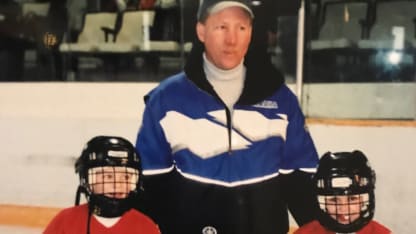
In most ways, Travis and his siblings were just regular farmland kids. They watched some NHL hockey on TV, squabbled and loved one another. The boys played Xbox (and, years later, would still play and talk to each other on their headsets) and had a circle of friends whom they looked forward to seeing. Their closest friends, however, were one another.
"Taylor is my best friend. We talk to each other all the time about what's going on; hockey and also off-the-ice stuff," Travis said.
Travis and Taylor were also hockey teammates from a very young age. Travis was always a defenseman despite his offensive prowess, while Taylor was a forward. Taylor was the feistier of the two on the ice, playing more of a checking role and being a more regular visitor to the penalty box than Travis.
"I like playing defense. There's more ice time, and a lot of responsibility. So I was happy to play D," Travis said.
Travis and Taylor Sanheim played together throughout their minor hockey days, from the bantam level in Elkhorn and midget level with the Yellowhead Chiefs and, later, in the Western Hockey League with the Calgary Hitmen. Being teammates was the norm, so it was easy to take for granted. Now that those days are over -- there was not a pro career on the other side of Taylor's junior days, although he still plays -- Travis looks back gratefully on those years together.
"To play with your brother, especially your twin brother, is something that only a few players get to experience. At the time, I didn't think much about it, because we'd just go out and play but now I look back and it was definitely pretty special," Travis said.
RISING WITH A BULLET FOR THE HITMEN
Travis Sanheim was not a heralded prospect when he arrived on the Calgary Hitmen. Standing a shade under 5-foot-10 at the time, the defenseman was a ninth-round pick (177th overall) in the 2011 WHL Bantam Draft. He debuted with the Hitmen in 2013.
Sanheim hit a late growth spurt, growing five inches within a year. Taylor grew to 5-foot-11 and father Kent is also of average height. Travis, however, shot up to 6-foot-3 and then another inch of height beyond that the following year.
On the ice, things didn't go well for Travis early in his WHL career. He had his share of growing pains with Calgary the first half of his rookie season.
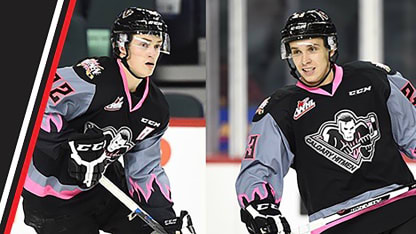
"I remember one time -- actually I was just talking about this with Patty [Nolan Patrick] the other day, because he was playing for Brandon -- where I played on a wing. Otherwise, I would have been scratched," Sanheim recalled.
Before long, however, Sanheim settled in. He kept things very simple early in the season. He posted three points through the first 21 games of the season as he focused mainly on positional play. His growing frame, smooth skating and first-pass ability were sufficient to get him the 167th spot on the Central Scouting mid-term list.
Thereafter, Sanheim got increasingly comfortable and started to assert himself offensively. As his role grew into that of all-situations player, Sanheim's point totals rose steadily. Sanheim's rapid development was partially hastened by an injury to Hitmen captain Jaynen Rissling (a Washington Capitals prospect at that time).
Paired with fellow 2014 Draft draftee Ben Thomas, Sanheim finished the season with five goals, 29 points and a plus-25 ranking. Sanheim also made a strong final impression on NHL scouts. Once again paired with Thomas, he had a very strong Under-18 World Championships tournament for Canada, posting six assists and a plus five rating in seven games while also taking care of business in his own of the ice.
Sanheim's final Central Scouting rating was 53rd on its North American rankings for the 2014 NHL Draft, which took place at the Wells Fargo Center.
Media who go primarily by that list were subsequently shocked when his name was mentioned as a first-round draft candidate on Draft Weekend. That is not actually how the Draft works, however. NHL Central Scouting's rankings are useful as a rough guide for how NHL team scouts may view the pool of candidates but the Central Scouting staff may see one thing in its observations and teams see another in their viewings.
Every NHL organization has its own internal rankings of prospects that could, on the surface, differ widely from what other teams and Central Scouting produces. One team may have a player in its top 10 whereas another organization has the same player 35th and Central Scouting has him 15th on its North American/European list. While that sounds like a huge disparity, the reality is that, beyond the obvious top-end players who are the clear-cut top few picks in a Draft year, the team-to-team projections of upside are often subtly different from one another, but those subtle disparities can make a big difference in one internal ranking to the next.
At the 2014 NHL Draft Combine, Sanheim met with all 30 NHL teams. Even teams that were simply doing a little extra due diligence on the player but had early first-round picks had him under consideration in the event they acquired an additional pick later in the round or early in the second round. If he had fallen to the second round, Sanheim was a strong candidate to be taken by the first team that did not have a higher-ranked player on its "first-round candidate list" fall to them.
That, of course, did not happen. The Flyers snapped up Sanheim with the 17th pick of the first round. On hand for the occasion was Travis' entire family, including Taylor.
"That was pretty awesome, to be drafted by the Flyers when the Draft was in Philly," Travis recalled. "Everyone was very nice to me."
Later, when Travis signed his NHL entry-level contract with the Flyers, he asked Ralph Zander, who along with wife Karen, has been a longtime billet for Calgary Hitmen players -- including the Sanheim brothers -- to be his witness at his contract signing.
"The Zanders were really good to me. I was away from home and they were pretty supportive of me. That meant a lot. I was able to focus on my hockey, and they took good care of me," Travis recalled.
Over the next two seasons, Sanheim's offensive game exploded. In 2014-15, he racked up 15 goals and 65 points in 67 games, leading all Western Hockey League defensemen in total points and ranking third across the entire CHL. The following season, Sanheim missed 15 games due to injury but still posted another 15 goals and increased his overall points to 68, leading all CHL defensemen in points-per-game average. Sanheim also earned a spot on Team Canada at the 2015-16 World Junior Championships, although he was confined to a power play specialist role and was used sparingly at 5-on-5.
BECOMING A PRO
For all of the points Sanheim was accumulating, he still needed work before he was NHL-ready. A big part of the reason lay in the Hitmen's style of play. With many of their best forwards either graduated to the professional ranks or having aged out of CHL eligibility, the team relied very heavily on Sanheim (and, later, on fellow offensive-minded defenseman Jake Bean) to lead the attack from the back end.
When Sanheim turned pro in 2016-17 and joined the Lehigh Valley Phantoms in the American Hockey League, he faced a steep learning curve to adapt to the much more heavily structure nature of professional hockey. Whether it's the AHL or the NHL, defensemen are expected to join the attack but not to be out in front of it.
The experience was an eye-opener for Sanheim.
"It was harder than I thought it would be," Sanheim admitted. "The AHL is a really good league and, obviously, the NHL is the best league in the world. I definitely had to make adjustments."
Helping Sanheim along his path to the NHL were coaches such as Flyers defense development coach Kjell Samuelsson and Phantoms assistant coach Kerry Huffman.
"I have worked with different coaches at different stages of my development, and Sammy and Huff were both a big help to me," Sanheim said.
Sanheim spent much of the first half of his AHL rookie year -- just as he had in junior hockey -- trying to simplify things and adapt to the defensive part of the game. From December onward, he came alive offensively, too. All 10 of his AHL rookie year goals were scored from December onward and well as the bulk of his overall 37 points.
WELCOME TO THE SHOW
Sanheim earned an NHL spot with the Flyers out of training camp in 2017-18. He dominated at times in the preseason, including a two-goal game at Madison Square Garden against the New York Rangers.
However, once the regular season started, Sanheim found that his learning curve was still not complete. He showed promise in his puck-moving ability and up-ice play but needed to tighten up a number of aspects of his game without the puck as well as some of his decision making with the puck that led to opposing odd-man rushes. For awhile, Sanheim settled in. However, by his own admission, he hit a wall around midseason. Eventually, he became a frequent healthy scratch. He was sent back down to the Phantoms.
As with any player in his situation, Sanheim was disappointed. However, he was also introspective. In his case, the assignment back to the AHL came as almost a relief.
"My confidence was down for awhile there, and I wasn't playing. We had a game, I think against New Jersey, where I remember thinking, 'Nothing is working right now.' When I was sent back to the Phantoms, I was kind of just looking forward to playing a lot of minutes, working on my game and letting the rest [in terms of coming back up to the NHL] take care of itself," Sanheim said.
During his 18-game return to the Phantoms, Sanheim rediscovered his mojo. He posted 16 points but, even more importantly, simply relaxed and played the game. His two-way game got back in synch and he became more confident and assertive.
When Sanheim returned to the big team, teammates took immediate notice of the difference.
"He talks now, for one thing," said teammate Radko Gudas with a grin and a nod toward his frequent defense partner from the first half of the 2017-18 season and duration of the 2018-19 campaign to date.
Teammate Shayne Gostisbehere was a bit more expansive on the subject.
"To see the way they handled everything, 'Sanny' goes down to the minors and he comes back. You could ask anyone in this room he was night and day better. He took a lineup spot away pretty much, but he deserved that because he put in the work, he got a lot better," Gostisbehere said.
In the playoffs against the Pittsburgh Penguins, Sanheim averaged 15:30 of ice time. He received second-unit power play duty and was only minus-one at even strength in a series were the Flyers were blown in Games 1, 3 and 4. Sanheim also scored his first Stanley Cup playoff goal; a center point shot through traffic in Game 3.
For Games 5 and 6, Flyers head coach Dave Hakstol replaced Sanheim in the lineup with fellow rookie Robert Hagg in an effort to get more physicality into the lineup. The coach moved up Andrew MacDonald (who had been paired with Sanheim) to play with Ivan Provorov, reunited the early season duo of Gostisbehere and Hagg, and opted to keep together veterans Brandon Manning and Radko Gudas.
After the Flyers were eliminated from the Stanley Cup playoffs, Sanheim and fellow rookie Oskar Lindblom were assigned to the Phantoms for the Calder Cup playoffs. At the time, Lehigh Valley was tied 1-1 in their best-of-five first round playoff series with the Providence Bruins.
The reinforcements were much needed from the Lehigh Valley standpoint. The Phantoms went on to win the Providence series in four games, with Sanheim and Lindblom each playing vital roles. Sanheim played top pairing minutes along with Philippe Myers. Unfortunately, a sprained MCL suffered in game one of the second round of the playoffs sidelined Sanheim for much of the second round series against Charlotte. He returned for the Eastern Conference Finals against the Toronto Marlies but the Phantoms were swept in four games.
THE HERE & NOW
Sanheim attacked his off-season regimen with gusto in the summer of 2018. He was determined to spend the full season in the NHL this time -- and a regular part of the starting six.
Despite an injury suffered in the first game of the preseason, Sanheim had a good camp. When the regular season got underway, he was paired again with Gudas after primarily playing with MacDonald down the stretch of his rookie year.
While the Flyers as a team have been streaky in the first two months of the current season, Sanheim's play has been a bright spot. There have been a few hiccups within games and a few rough nights in the mix but they haven't lingered. Sanheim has had more good games than bad ones, and his level of confidence is now such that he's no longer trying to prove he belongs in the NHL. He knows he belongs and now wants to make a bigger impact across the board.
"I believe in myself and our team," Sanheim said. "I think I can continue to improve, and our team has a lot better hockey in us than how we've played so far. We've shown that at times. We just need to be more consistent."


